The LEGO Technic fan community has always been as diverse as possible, consisting of kids building simple cars, teens assembling larger sets and adult fans creating incredibly complicated LEGO mechanisms. Designing a product that will be liked by an audience this broad sounds like a dreadful challenge, and one of the possible solutions is releasing a model bigger and heavier than any other set before. This way comes LEGO Technic 42082 Rough Terrain Crane, a gigantic model of 4057 pieces retailing for $299.99. The new crane becomes the largest LEGO Technic set to ever hit store shelves, but this larger scale is not without some potential flaws…
Packaging
The sealed box is absolutely massive. It weighs around 5 kg/11 lbs. Despite its size it is still way too small to fit the model entirely on its front. However, under the front flap hides a picture of the crane with its boom fully extended. All other functions are illustrated here as well.
Inside the box are 26 bags with pieces (7 bags fewer than in 42055 Bucket Wheel Excavator) divided into 13 steps, 4 rims and 4 tyres, 2 thick sections of the building guide, a battery box and a Power Functions L-motor.
It’s usually hard to find a reason to criticise the packaging of LEGO sets, but here’s something I was very confused by. Nowadays, plastic bags with pieces come in 2 different designs — one with a white stripe in the middle (new design) and the other is without it (old design). I have nothing against bags of both designs mixed in one box, but you have to be extra careful with bags #6 and #9. While old bags had a distinctive dot after the number 9, bags of the newer design don’t have one. And this is how I got a picture like this:
It was only several hours into the build process when I noticed that there was only one bag #6, but two bags #9. Of course, it isn’t something critical, but a child building the crane might be really confused with a lot of “unused” pieces from an incorrectly opened bag.
The concept and the prototype
The concept of the rough terrain crane is quite simple. This vehicle is a rather compact 4- or 6-wheel mobile crane with a telescopic boom suitable for work in stiff terrain, where jobsite flexibility is valued. Mobile cranes are usually equipped with 2 pairs of outriggers and either a 4-4-4 or 6-6-4 driving/steering scheme, meaning that all wheels are driven and both the front and the rear axles provide steering. For instance, the crane in this set has a 4-4-4 chassis with 2 differentials. This LEGO set does not officially depict a specific real-world crane. However, considering the size of the model and its proportions, the most probable prototype is the Liebehrr LRT 1090-2.1, whose chassis measures nearly 8.2 meters/27 feet long. The Technic model is about 48 cm/19 in long (chassis only), so the approximate scale of the model is about 1:18, which is rather common among huge flagship sets.

Parts analysis
The most surprising thing about this 4000-piece set is that none of those pieces are new designs. However, there are a couple of parts in new colors. Curved gear racks 11 x 11 that only came in yellow before, now are in black for the very first time. There are 8 of them in the set — just enough to built two full circles.
The only other piece in a new color is a curved paned 7×3 with 2 pin holes that has never been released in red before. You’ll find 4 panels in the set, which can be a nice bonus for your collection of Technic panels.
Here are some other pieces that can be of interest for LEGO Technic fans:
- Thick T-shape liftarms 3×3 in red. 42075 First Responder is the only other Technic set that has these as well;
- Thick perpendicular H-shape liftarms 3×5 first appeared in red in 2017, but they are still pretty hard to find;
- Curved panel 7×3 with 2 pin holes in dark bluish gray isn’t very common today, but you can find two of them in this set;
- 32126 — axle and pin connector makes its third appearance in white in this set as well.
Finally, tires 94.3x38R make a comeback after a 2-year-long pause.
Tastes differ, and while some fans are madly in love with the designs of the recent supercar sets, others are delighted with motorised functions of the flagship builds. Whichever side you take, it’s hard to argue that any heavy LEGO Technic set is a brilliant source of pieces for future creations. 42055 Bucket Wheel Excavator released in 2016 became the biggest LEGO Technic set at the time with 3929 pieces. Now, 2 years later the Crane sets a new record of 4057 pieces. Moreover, today, 4 of the 5 largest LEGO Technic sets are available in stores: 42056 Porsche 911 GT3 RS, 42083 Bugatti Chiron, 42055 Bucket Wheel Excavator and 42082 Rough Terrain Crane. Let’s have a look at the numbers and compare these 4 massive sets:
| Set number and name |
42056 Porsche 911 GT3 RS |
42083 Bugatti Chiron |
42055 Bucket Wheel Excavator |
42082 Rough Terrain Crane |
| Year of release | 2016 | 2018 | 2016 | 2018 |
| Piece count | 2704 | 3599 | 3929 | 4057 |
| Retail price | $299.99 | $349.99 | $279.99 | $299.99 |
| Price per piece | 11.1 c | 9.7 c | 7.1 c | 7.4 c |
However, since two of these sets are collectible models of supercars and the other two are flagship models of construction machines, the distribution of the pieces between several basic categories is what matters for someone willing to broaden their building resources:
| Set number and name |
42056 Porsche 911 GT3 RS |
42083 Bugatti Chiron |
42055 Bucket Wheel Excavator |
42082 Rough Terrain Crane |
| Axles | 207 (7.7%) | 212 (5.8%) | 282 (7.2%) | 430 (10.5%) |
| Gears | 64 (2.4%) | 67 (1.9%) | 139 (3.5%) | 151 (3.7%) |
| Connectors | 294 (10.9%) | 361 (10%) | 350 (8.9%) | 593 (14.6%) |
| Liftarms | 559 (20.7%) | 663 (18.4%) | 856 (21.8%) | 766 (18.9%) |
| Panels | 92 (3.4%) | 119 (3.3%) | 38 (1%) | 73 (1.7%) |
A decent amount of gears, connectors and axles makes the new crane almost a perfect choice both for beginners, who may still be short on key building elements, and experienced builders who can enjoy building the model and use these piece for another massive creation. However, we can’t recommend getting the new crane for the sake of panels: Because of the tower’s asymmetrical structure, you’ll notice that most of the panels come in uneven amounts.
Stickers
A vast sticker sheet comes with 46 numbered sets and 72 stickers in total. There are no stickers bigger than a medium-sized panel, and almost all of them are complementary; they do not change the look of the model too much, as they did on the 42077 Rally Car set.
The building process and its challenges
It all starts with a bunch of colorful liftarms and gears of nearly every kind. The result of the first bag reminded me of a clock mechanism, and actually it is a very complicated reduction gear box that will be used to rotate the crane tower.
It makes me sad, but I have to start the review of the building process with a huge portion of criticism. No doubt, such a massive and heavy model requires some extra strong framing, which is why there are so many liftarms and pin connectors. But with more complicated structures every small assembly mistake costs way too much time and pleasure. I consider myself to be an experienced LEGO Technic builder, but somehow I forgot to place a small 8—tooth gear during the very first pages of the guide. It was as late as the bags numbered #11 (of 13) when I discovered that the tower wouldn’t rotate when it should. By that time, more than 3,000 pieces had been used already, covering over the rotating mechanism completely. The worst part of it was how impossible it was to look inside the model and to find the place where the piece was missing. It took me another hour to partially disassemble one side of the crane and to squeeze in the missed gear using small tweezers.
Each step of the building process includes a short list of pieces that are required during this particular step, and my fault was not being attentive enough. On the other hand, I would say that massive sets like this one lack check points that will help you try all the mechanisms as they are being assembled. Being able to find a mistake as early as you made it would save a lot of time, but discovering one small mistake 3,000 pieces later is a little bit heartbreaking.
(Editor’s note: In Alexander’s defense, Chris — another experienced Technic builder writing reviews for TBB — made a similar mistake early in the build process for 42083 Bugatti Chiron and was forced to disassemble the set to repair that early mistake. Not fun.)
The overall pace of the assembly is rather quick, and the build grows fast with each new bag of pieces. Very soon both both drives and 2 pairs of outriggers are all set and secured.
Only once outriggers are attached, it becomes clear how massive the chassis is, both in terms of size and weight. However, it is still light enough for outriggers to support the whole structure.
During the next step, a couple of decorative elements are placed on top of the base. Even though the model features the V-8 engine built with the (boring) regular pieces, I love how an oil filter is attached right next to it. In general, it’s a very small and insignificant element, but the only other set that included any attachments to the engine was a V-8 from 42050 Drag Racer that came with couple of improvised air filters.
Beside the engine, a flat black panel and a barrier are placed on the other side of the chassis.
The next step is probably the best thing about the whole model in terms of engineering and use of LEGO pieces. Those of our readers who enjoy assembling larger LEGO Technic sets will know that turntables form a narrow category of Technic pieces used for machines with rotating towers and booms. Usually turntable pieces are no bigger than 8-9 studs in diameter, and obviously such a small joint won’t be able to support a 1,500-piece-heavy tower for a construction crane. The LEGO Technic design team solved this problem in the most elegant way — they chose to build a massive turntable with a roller-bearing assembly. The whole step #6 of the instruction booklet is devoted to the turntable, which use the new 11 x 11 curved gear racks. In the picture below you can see a side-by-side comparison of two turntables — a very small one in the centre and a giant circle made of curved racks around it.
Once the bottom circle is assembled and attached to the chassis, it’s time to build one of the most weird-looking things I’ve ever seen in a LEGO Technic set. A transitional ring consists of angled connectors and 8 small train wheels that act as rollers inside the turntable.
Moments later it is placed on top of the lower circle. I must admit, I was geniuenly surprised with how well both parts fit each other.
The next step applies the top circle. It is secured to the chassis through the center of the turntable with a bunch of pins, so the whole structure can be freely rotated in both directions, yet it sits very, very firmly.
A bit later the chassis is decorated with wide mudguards, ladders, headlights and backlights.
To be honest, I do not like attaching wheels till the very end of the building process; with no wheels attached the model is much easier to handle and the tyres stay clean of dust. However, at this point the chassis becomes too heavy to be supported by the outriggers only, so you have to place all the wheels to continue.
It all continues with the tower. Once again, it’s time for many, many gears as the main gearbox is being assembled.
Another brilliant piece of the set is the medium thick string, which first appeared in 42070 6×6 All Terrain Tow Truck in 2017. Judging by the official LEGO piece number, the string that comes with the crane is longer than the one for the tow truck, and seems to be at least 2 meters long. It feels very strong and a little bit stretchy, and seems to be perfect for such a large model.
Eventually, an L-motor and a battery box take their rightful places. And while the battery box can be easily removed, the motor is secured with several liftarms and connectors; you won’t be able to take it out without removing a whole lot of other pieces.
The moment when the body of the car is being attached to the chassis in the automobile factory is called “the marriage”. In the case of the crane, the “marriage” happens when the tower meets the turntable. There is only one axle running though the center of the turntable connecting the motor with the rotating mechanism inside the base.
You might have spotted a couple of white rubber bands right in front of the battery box placed between two thin yellow liftarms. Their function isn’t as obvious as the other parts of the crane, but they are crucial for the model. These bands do not transmit any rotation, but instead create additional friction for the axles they are banded with. Because of the size of the model and considering a really long boom, some mechanisms may accumulate unwanted stress concentrating in numerous connectors and gears. This stress may result into backing run, especially when the gearbox is switched to neutral. The rubber bands help fight any reverse rotation by keeping the axles in set positions.
One step later the boom is attached to the tower. Usually mobile crane booms are equipped with rope extending mechanism: a block and tackle pulley system sitting inside the boom that allows fast telescoping. This mechanism can be easily recreated with LEGO pieces, and we’ve seen it in 8421 Mobile Crane back in 2005. Unfortunately, the new mobile crane doesn’t include this feature.
The rest of the pieces help complete the covering of the tower. This is where all the red Technic panels are being used. Finally, a very stylish crane cab takes its place on the left side of the tower. The crane is finally completed. All in all it took me about 24 hours over a span of 3 days to build the model.
The final touch is 4 building sections made with liftarms and panels. I can’t think of any other accessory that would be this simple, but would bring so much playability to the set. Lifting and trying to put any of the walls in its correct position is a lot of fun.
Design and impressions
Designing with Technic panels and liftarms is never an easy task, and usually the result is either a total win or an awful failure. Sometimes stickers can transform the model’s boring look, but as I mentioned above the set of stickers for the crane is purely complimentary. The crane’s entire look is done through a very fine choice of panels completed with a wide range of small details and accessories, like this very cool fire extinguisher attached right behind the cab. There’s also a corresponding sticker right underneath it.
The design of stickers is so minimalistic and clean, you won’t notice many of them if you’re not looking for them on purpose. Additionally, the red color of the stickers perfectly matches the color of the ABS plastic the pieces are made of.
Actually, I love the purpose of stickers in this set. They do not influence the shape of the crane, but rather fill empty spaces and emphasise things that need your attention. For instance, a whole bunch of pinch point labels are placed by the exposed gears on top of the tower. Hiding gears inside the body would cost space and panels, and stickers help to solve this problem in a very elegant way.
Neither the front, nor the rear of the chassis looks aggressive or futuristic. Many other LEGO Technic sets were criticised for their unrealistic shapes, proportions or colors, but I can’t say the same about this set. Headlights, back lights, mirrors, ladders, handlebars and barriers — all of these look very believable and appropriate.
It’s hard to say if red is the best color for a set like this. No doubt, another yellow crane would have been received by the fan community without enthusiasm, while a white one would look very pale and an orange model would be way too bright. I tend to think that red was a nice choice by the designers, while my favourite spot of red is the red rims with black wheel covers.
Functions and playability
There are 9 different motorised functions that can be activated through 3 switches and one huge gearbox, which sits right behind the boom. You can see one of the switches to the left of the gearbox that allows you to choose between activating mechanisms sitting inside the chassis (the outriggers and the tower rotation) and mechanisms located inside the tower (the boom and the winch functions). Again, stickers provide an ideal solution by displaying onboard instructions, ensuring playability is never lost.
A couple of additional switches are located on both sides of the chassis.
Just like a real-life mobile crane, this model comes with four outrigger pads. These are made with 6×6 tiles in dark bluish gray, and can be stored in a compartment under the boom in the front part of the crane. And they actually work: they help to increase the stability of the crane significantly.
A tiny storage compartment on the each side of the crane is yet another surprising feature of the set. The inner space of the storage sections are entirely made with Technic liftarms and feel very sturdy. Inside are absolutely adorable boxes containing tools and a couple of short chains.
It would be totally unfair not to mention the brilliant design of the cab’s door. This is a sliding door made with an amazingly simple combination of short liftarms and pin connectors. When opened it slides to the back of the cab revealing the cab’s interior. A door like this is an absolutely unnecessary thing for a heavy motorised monster like this crane, but this is what makes it particularly special for the fans.
As was mentioned in the very beginning of the review, both drives are steerable giving the crane some high manoeuvrability. I wouldn’t call it extraordinary, but steering works very smoothly and allows a lot of playability even on very limited surfaces.
The rear part of the tower sits on just three pins. Once removed it gives full access to the motor and the battery box. Changing dead batteries won’t be a problem at all.
One of the most anticipated tests of the crane is its lifting capacity. LEGO Technic cranes have never been among the best top-lifters; the second biggest LEGO Technic crane, 42009 Mobile Crane Mk II could only lift about 500 grams/1.1 lbs of cargo. Surprisingly enough, the new mobile crane is capable of lifting twice as much. We managed to make it lift up to 1.1 kg/2.4 lbs of Pepsi cans before the winch mechanism started to give up. Loading the crane with heavier cargo can result in severe damages to the turntable mechanism, so we won’t recommend pushing it to the limits.
However, despite possible weak spots of the model, the crane is extremely robust. You can easily grab it by the chassis, by the tower, by the boom and lift it up in the air. We don’t want to conduct a drop test, but we firmly believe the crane will survive the most harsh scenarios for sure.
Still, the main play scenario is assembling a structure using elements of a building. And it is pretty enjoyable! The speed of the functions allow some very precise control of the height of the boom and the length of the winch, so you can easily try yourself to be a crane operator.
Conclusion and recommendations
What can be better that an awesome LEGO set? Probably, a bigger, more awesome LEGO set! We’ve seen a lot of outstanding LEGO Technic sets during the last 3-4 years, each of them being bigger and more complicated than any model before. The new 42082 Rough Terrain Crane beats all of them in terms of both size and piece count. And judging by its functions and a very solid choice of pieces it offers, the set easily lands at the top of the list of the most attractive LEGO Technic sets of recent years.
LEGO Technic 42082 Rough Terrain Crain includes 4057 pieces.
The set is available now from the LEGO Shop ($299.99 in the US | $349.99 in Canada | £229.99 in the UK), Amazon.com, and elsewhere. The set is also available from third-party sellers on eBay and BrickLink.
The LEGO Group sent The Brothers Brick an early copy of this set for review. Providing TBB with products for review guarantees neither coverage nor positive reviews.




















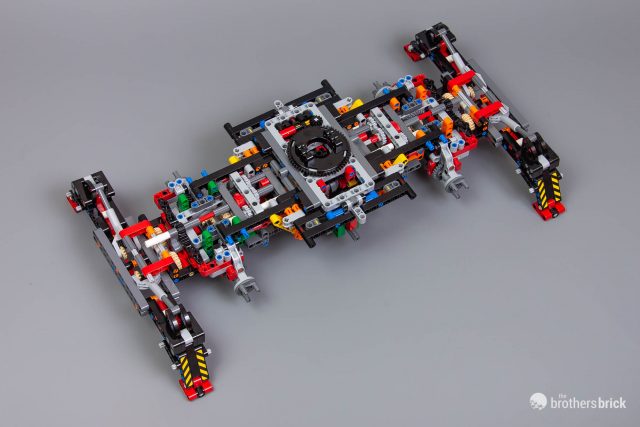






























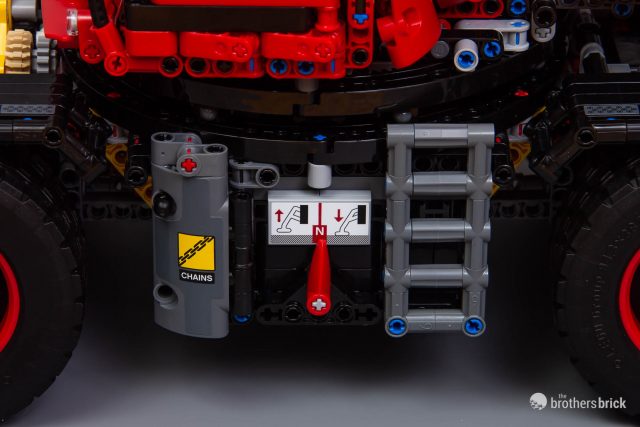
































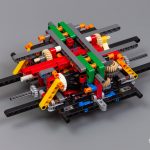



















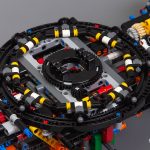






































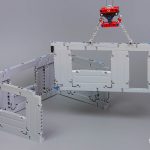


Fantastic review – so well written, perfectly detailed, outstanding photographs – a pure joy to read! Your ability to get the set built (whilst making notes and photographs) on time and the review written for launch day is remarkable too. I especially liked the commentary on
the availability of elements in this set compared to others of similar ilk. Thanks Alexander!
What parts are used to attach the train wheels to the ball bearing assembly?
Nice, but for the price they could have included 2 extra motors to drive the crane.
Very well written, love the price point comparisons. Thanks for a great review!
This set looks like it would make a good starting point for an incredible build of Sophia the 3rd from Blaster Master…
Thank you so much, @Miffy! Comments like yours is what inspires us to keep on blogging!
@Pete, this are Bar 1L with Towball https://www.bricklink.com/v2/catalog/catalogitem.page?P=22484
@Ivano, the inner structure of the chassis is so complicated and dense, there’s absolutely no space for one, not even two more motors. But you can always try to motorise it yourself.
I bought this set on its release day and I couldn’t be happier with it! Excellent write-up, and I couldn’t agree more about wishing that LEGO gave you some directions on how to test all of the gearing on such a complicated gear box before you start fully covering it up! When I got the motor installed and fired it up, nothing would move and I was not looking forward to taking apart so many pieces to find the mistake. Fortunately, I had simply forgotten to engage the upper/lower switch…once I flipped that, everything worked! Talk about a relief!
I was surprised how little LEGO marketed/displayed this set! Up until about a couple weeks before the release, I could hardly find any info about this set other than some really mediocre photos. And on release day, my local LEGO store only had 3 copies and they weren’t even displayed in the store! I know it’s a pricey set, but I figured there would be a lot more interest…maybe everyone isn’t as big of a Technic fan as I am!
Thanks for this great review – whenerver I new set comes out I always head straight to this site to see if it’s been reviewed. Not sure I’ll buy this as I have a mountain of Technic stuff already (and I just bought the bugatti Chiron) but still really enjoyed reading the review.